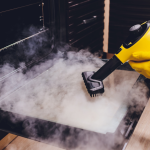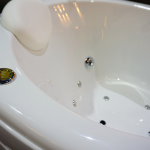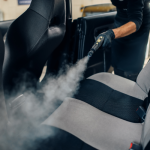Removing road paint from a car’s surface can be a challenging task, especially when considering the potential harm it can cause to the vehicle’s paint. While using paint strippers or thinners may appear effective, they often pose a risk of causing irreversible damage to the car’s exterior.
In such situations, employing alternative approaches like specialized car wash solutions and gentle cleaning techniques can ensure the road paint is removed without compromising the integrity of the car’s paint. By adopting a careful and precise method, it’s possible to effectively eliminate road paint while preserving the quality and appearance of the vehicle’s surface.
What to do if your car has been vandalized
If your car has been vandalized, it’s essential to take the following steps to ensure your safety and document the incident for insurance purposes:
Ensure personal safety
- Before approaching your vehicle, assess the surrounding area for your safety. If the damage is extensive or if you feel unsafe, contact local law enforcement immediately.
Document the damage
- Take photographs of the vandalism from various angles to accurately depict the extent of the damage. This visual evidence will be crucial for insurance claims and police reports.
File a police report
- Contact the local police department to report the vandalism. Provide them with all relevant details and any evidence you have, such as photographs or eyewitness accounts, to aid in their investigation.
Notify your insurance company
- Inform your insurance provider about the incident promptly. Provide them with the necessary documentation, including the police report and photographs, to facilitate the claims process.
Repair the damage
- Depending on the severity of the vandalism, you may need to seek professional repair services. Choose a reputable auto repair shop that specializes in addressing the specific type of damage your car has sustained.
Take preventative measures
- Consider installing security measures like surveillance cameras or an alarm system to deter future vandalism. Parking your car in well-lit areas or secure garages can also help minimize the risk of recurrence.
By following these steps, you can effectively address the situation and reduce the potential financial and emotional impact of vandalism.
Types of aerosols suitable for your car
If your vehicle’s paint job has been damaged and requires touch-ups or modifications, it’s important to use aerosols correctly for the best results and avoid potential harm to the existing paint. Misusing aerosols for outdoor car paint spraying can result in damage that can be costly to repair.
Here are four types of paint suitable for spray applications on cars:
- Water-based: Water-based paints are environmentally friendly and provide a smooth finish. They are often used for basecoats and are known for their low toxicity.
- Nitrocellulose: Nitrocellulose paints are quick-drying and offer good adhesion. They are commonly used for vintage cars and musical instruments.
- Acrylic urethane: Acrylic urethane paints are durable and resistant to UV damage. They provide a glossy finish and are commonly used for modern vehicles.
- Acrylic enamel: Acrylic enamel paints offer excellent durability and resistance to weathering. They are suitable for both older and newer cars and provide a glossy finish.
When selecting an aerosol paint for your car, consider the type of paint job you need and the specific requirements of your vehicle. Proper application techniques and suitable paint types are essential for achieving the desired results without damaging your car’s appearance.
Don’t worry, removing spray paint from your car is entirely possible. When we notice stains on our vehicles, it’s natural to feel concerned and wonder how they happened. When it comes to spray paint, we may have mixed emotions, questioning whether it occurred while parking downtown or under different circumstances. However, it’s important to remain calm, as this problem is not permanent, and there are several straightforward methods to restore your vehicle.
Assess the damage
Discovering unwanted paint on your car is never a pleasant sight for any car owner. Nevertheless, it’s crucial to examine the entire perimeter of the vehicle to determine the extent of the damage.
Tips and tools for dealing with spray paint
When dealing with spray paint on your car’s surface, it’s vital to employ suitable and specialized cleaning techniques and products specifically designed for automotive use. These may include gentle solvents, soaps, or cleaners recommended for paint removal without harming the car’s original finish.
It’s advisable to seek advice from a professional auto detailer or a trusted automotive expert to determine the safest and most appropriate method for removing spray paint from your car without causing additional damage.
Below, you’ll find some tips for the entire process of removing spray paint and various tools that might be the right solution for your situation.
Wear protective gear
If you decide to remove spray paint from your car’s surfaces yourself, it’s crucial to wear protective gear like rubber gloves and goggles.
Paint scraper
A handheld tool that uses plastic and steel blades to remove paint through manual effort. Use plastic blades for softer materials like copper to prevent scratches. Scrapers come in different sizes, so choose one that suits your needs. Ideal for smaller surfaces where paint removal is relatively easy.
Add carnauba car wax
Carnauba car wax can effectively and gently remove paint from your car’s surface without scratching or damaging the finish. Apply the wax generously to a sponge or soft cloth.
Use a clay bar
A clay bar is another effective method for removing paint overspray. You can use it on car bodies or window frames. First, clean the affected areas with auto wash. Then, rub the clay bar up and down on the spray paint until the color is removed.
Use acetone
Acetone is effective for removing oils, acrylics, and enamel paints. It can be applied to paint with the addition of water. Acetone is readily available in bottles and can be purchased in various sizes. Begin by rinsing the surface with water, then saturate it with acetone. Allow it to dissolve the paint and add more acetone as needed. Use wire brushes for rough concrete surfaces and stiffer brushes for smoother areas.
Use nail polish remover
Nail polish remover should only be used if it contains acetone, as this is effective in removing paint. Apply nail polish remover to the affected plastic area before rubbing it for several minutes until all color disappears.
Baking soda (or vinegar) & heat
For metal surfaces, you can remove paint by mixing baking soda with water. Place the metal item in a disposable pot on the stovetop, add water, and 1/4 cup of vinegar. Boil the water and let the item simmer for at least 15 minutes or until the paint comes off. Use tongs to handle the metal when removing it from the pot. Scrape off any remaining paint with a putty knife or hard bristle brush. This method works well for small metal components like hinges or hardware.
WD-40
WD-40 can help soften and remove stripping paint from car surfaces without affecting the car’s finish. Continue the process until the paint concentration diminishes.
Petroleum jelly
Coat the paint scuff with Vaseline petroleum jelly overnight, then pressure wash the vehicle. This will remove a significant portion of the painted area.
Heat gun
Using a heat gun to remove spray paint from a car involves setting the heat gun to a low or medium setting and holding it several inches away from the painted surface. Gently heat the spray paint until it softens, taking care not to overheat the area. Use a plastic razor blade or a plastic putty knife to gently scrape off the softened paint. Work in small sections, reapplying heat as needed. Wipe the area with a clean cloth and a mild solvent to remove any remaining residue. Always use the heat gun cautiously to prevent damage to the car’s paint.
How to remove spray paint from any car surface?
Removing spray paint from a car’s surface requires a careful approach to avoid damaging the underlying paint or metal surfaces. Avoid using harsh chemicals such as paint thinners or paint strippers, as they can do more harm than good. Instead, consider using specialized automotive cleaning products designed specifically for this purpose, available at auto parts stores. Begin by gently washing the affected area with a mild detergent and warm water.
For tougher stains, use a non-abrasive cloth or sponge with a designated solvent recommended for automotive use. Be sure to test the solvent on a small, inconspicuous area first to avoid any potential adverse reactions with the car’s paint.
Finally, apply a protective wax or sealant to the treated area to restore the car’s surface to its original shine and protect it from further damage.
Home remedies for removing paint scuffs
When dealing with paint scuffs on a car’s surface, several household remedies can effectively minimize their appearance.
One simple method involves using a mixture of warm water and mild soap, applied with a soft cloth or sponge, to gently rub the affected area. For tougher scuffs, a combination of baking soda and water can act as a mild abrasive, helping to lift the paint residue without damaging the car’s surface.
Additionally, the careful application of white vinegar on a soft cloth can aid in loosening and removing the scuff marks.
By combining these home remedies with some effort and the use of gentle materials such as a soft-bristled toothbrush or a paper towel, you can often achieve satisfactory results in minimizing the appearance of paint scuffs on a car’s surface. However, always test these remedies on a small, inconspicuous area first to ensure they won’t harm the car’s paint job.
Here is a summarized step-by-step guide for removing scuff marks from car paint without causing any damage:
- Gather materials: Get a microfiber cloth, mild soap, warm water, and a soft-bristled brush.
- Prepare a cleaning solution: Fill a bucket with warm water and add a small amount of mild soap to create a gentle cleaning solution.
- Clean the surface: Dip two microfiber cloths in the soapy water and gently clean the scuffed area using light pressure.
- Rinse: Use a damp clean cloth with plain water to rinse off soap residue.
- Assess the scuff marks: If the scuffs remain, create a paste by mixing baking soda with water to form a mild abrasive solution.
- Apply the paste: Gently apply the baking soda paste to the scuff marks using the soft-bristled brush, avoiding excessive pressure.
- Rinse again: After scrubbing, rinse the area thoroughly with water to remove any residue.
- Final inspection: Once the area is dry, inspect the paint to ensure that the scuff marks have been effectively removed without causing any additional damage.
Remember to perform a spot test in an inconspicuous area before applying any cleaning solution to the entire affected surface to avoid potential harm to the paint or clear coat.
Regarding spray painting on various surfaces
Aerosol cans can be applied to a range of surfaces, including plastics, ceramics, glass, tin, concrete, canvas, and terracotta. It’s essential to prepare the surfaces properly for an even finish, which may involve cleaning or priming, depending on the material. Some decorative items can also be spray-painted, but avoid spraying areas that come into contact with food or drinks.
When removing spray paint overspray from different surfaces, tailored strategies are necessary to protect the underlying materials:
- For non-porous surfaces like glass or metal, a combination of rubbing alcohol and gentle scraping with a plastic scraper can effectively remove overspray without causing damage.
- On painted surfaces, a mixture of dish soap and warm water can create a gentle cleaning solution to dissolve overspray without harming the original paint.
- For wood or porous surfaces, a mixture of white vinegar and water can be applied with a soft cloth to break down paint particles without compromising the material’s texture.
It’s crucial to avoid using aggressive measures like paint strippers, as they can cause irreversible damage. By selecting appropriate cleaning agents and methods, it’s possible to safely and effectively remove spray paint overspray from various surfaces.
Here is a summarized step-by-step guide for removing scuff marks from car paint without causing any damage:
- Gather materials: Get a microfiber cloth, mild soap, warm water, and a soft-bristled brush.
- Prepare a cleaning solution: Fill a bucket with warm water and add a small amount of mild soap to create a gentle cleaning solution.
- Clean the surface: Dip two microfiber cloths in the soapy water and gently clean the scuffed area using light pressure.
- Rinse: Use a damp clean cloth with plain water to rinse off soap residue.
- Assess the scuff marks: If the scuffs remain, create a paste by mixing baking soda with water to form a mild abrasive solution.
- Apply the paste: Gently apply the baking soda paste to the scuff marks using the soft-bristled brush, avoiding excessive pressure.
- Rinse again: After scrubbing, rinse the area thoroughly with water to remove any residue.
- Final inspection: Once the area is dry, inspect the paint to ensure that the scuff marks have been effectively removed without causing any additional damage.
Remember to perform a spot test in an inconspicuous area before applying any cleaning solution to the entire affected surface to avoid potential harm to the paint or clear coat.
Regarding spray painting on various surfaces
Aerosol cans can be applied to a range of surfaces, including plastics, ceramics, glass, tin, concrete, canvas, and terracotta. It’s essential to prepare the surfaces properly for an even finish, which may involve cleaning or priming, depending on the material. Some decorative items can also be spray-painted, but avoid spraying areas that come into contact with food or drinks.
When removing spray paint overspray from different surfaces, tailored strategies are necessary to protect the underlying materials:
- For non-porous surfaces like glass or metal, a combination of rubbing alcohol and gentle scraping with a plastic scraper can effectively remove overspray without causing damage.
- On painted surfaces, a mixture of dish soap and warm water can create a gentle cleaning solution to dissolve overspray without harming the original paint.
- For wood or porous surfaces, a mixture of white vinegar and water can be applied with a soft cloth to break down paint particles without compromising the material’s texture.
It’s crucial to avoid using aggressive measures like paint strippers, as they can cause irreversible damage. By selecting appropriate cleaning agents and methods, it’s possible to safely and effectively remove spray paint overspray from various surfaces.




